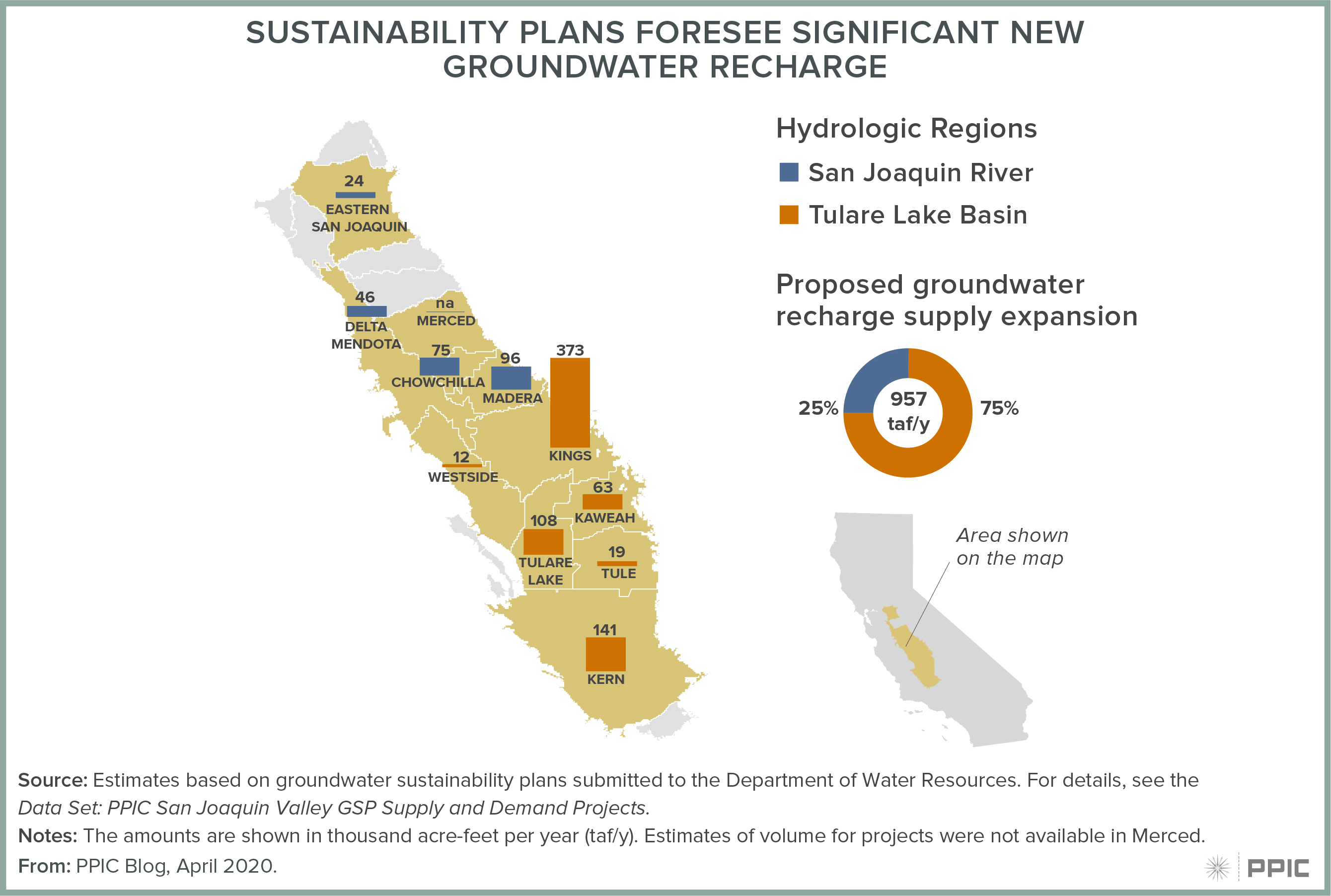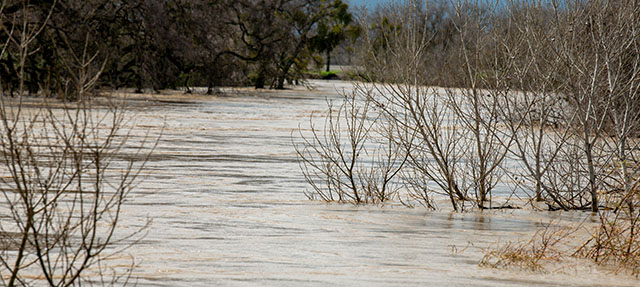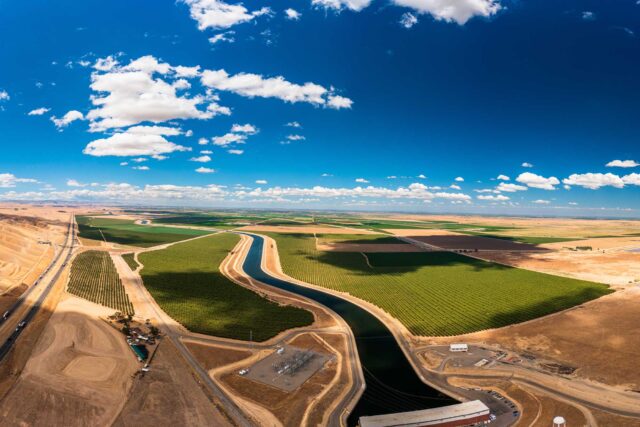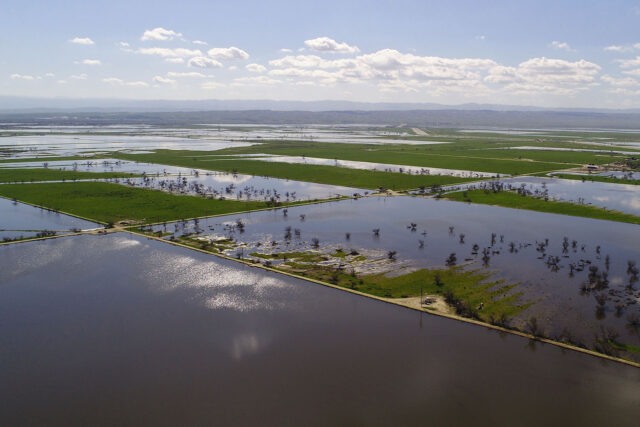In the midst of the COVID-19 crisis, work on managing groundwater for long-term sustainability continues, as required by California’s landmark Sustainable Groundwater Management Act (SGMA). In January, water users in 21 critically overdrafted basins delivered their groundwater sustainability plans to the state Department of Water Resources. In this series, we examine the 36 plans submitted for 11 critically overdrafted basins in the San Joaquin Valley—California’s largest farming region, where excess pumping is a major challenge.
How can floodwaters reduce groundwater overdraft?
Water users have two options for bringing overdrafted groundwater basins into balance: reduce pumping or increase groundwater supplies. In many places, recharging basins with floodwaters from winter and spring storms is one of the most promising supply-side approaches. With SGMA, interest in capturing this water is at an all-time high. In the San Joaquin Valley, 28 of the 36 groundwater sustainability plans propose recharge projects. Total demand for floodwaters is so high that it outstrips what is likely to be available. Competition could be fierce.
Allocating this water is the state’s responsibility, and developing an effective allocation system is a top priority for successful SGMA implementation. Ideally, this system should allocate floodwaters to generate the most benefits and encourage cooperation among parties to realize these benefits in the most cost-effective ways.

What is the state’s current approach for allocating floodwaters?
Previously, some water users have tapped unclaimed floodwaters for recharge, but there hasn’t been a formal permitting process until very recently. In 2019, the legislature enacted AB 658, authorizing the State Water Board to grant temporary permits to groundwater sustainability agencies and other public agencies to divert certain floodwaters. Based on this authority, the board also recently announced a permit system to establish permanent rights to divert and store floodwaters. This recharge water can be used to address various “undesirable results” of groundwater extraction as defined in SGMA, and diversions are limited to prevent harm to other legal users and aquatic species.
As with California’s system for permitting water rights, permanent rights to divert floodwaters will generally be allocated by seniority; those who first establish valid claims will have priority. Temporary permits will likely follow a similar priority system when water is available after satisfying the permanent rights.
Although these changes should make it easier to implement recharge projects, there are important shortcomings. Allocating water by the date of claim does not ensure it will be used to deliver the greatest benefits. It also encourages parties to fight to get to the head of the line, rather than to cooperate and plan to make the best use of this scarce resource.
Could an auction system improve the process?
In a recent article with colleagues from UC Berkeley and the Department of Water Resources, we proposed an auction approach as an alternative way for the state to allocate floodwaters for recharge. As in the current system, the state would set limits on how much water could be diverted within a watershed. But rather than simply apply for the right to divert and store high flow waters, parties would bid for this right.
Although parties would still be competing for the right to divert, this bidding process also encourages cooperation. To improve their chances of being selected, beneficiaries will have incentives to develop joint bids. Cooperative projects within and across groundwater basins will often have the best potential to mobilize funds for the investments needed to capture and use these waters.
By teaming up, parties can also develop projects that use the best locations for recharge—thereby lowering costs of this new supply. Bidding could also encourage cooperation with other beneficiaries—such as flood control districts that could benefit from reduced levee erosion or environmental groups who seek to increase wetland habitat on recharge lands.
Funding is another key difference between auctions and the current system. Right now, permittees pay a fee to cover administrative costs, but they do not pay for the water itself. In an auction system, the winning bidders would pay for the water. These funds could be used to support regional water management goals.
In short, the bidding process would spur creative, collaborative approaches to make the best use of recharge waters—with projects that bring the most benefits for the least cost. This would be a marked improvement over the currently planned “first-in-time, first-in-right” selection process, which does not explicitly consider the relative merits of competing proposals.
What’s next?
An auction approach can help coordinate stakeholders and improve the allocation of unclaimed floodwaters for recharge projects. Although legislation may be required to authorize it, existing California water law does not present an obvious impediment to adopting an auction system. Given its potential advantages over the current system, the state may wish to trial a round of auctions in river systems where recharge resources are likely to be scarce.
Note: The data on supply and demand options identified in the groundwater sustainability plans is located in Data Set: PPIC San Joaquin Valley GSP Supply and Demand Projects.





